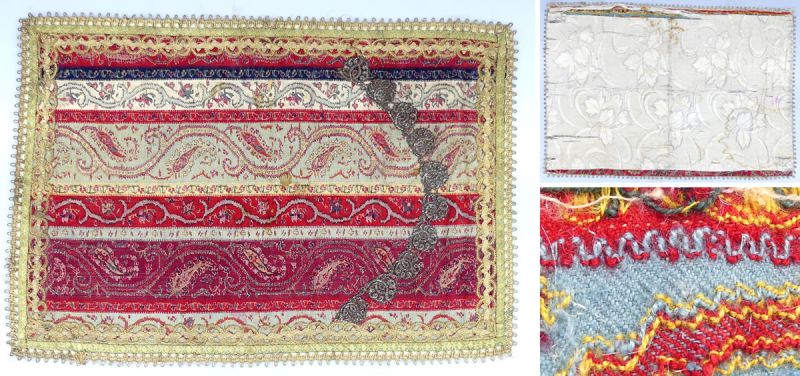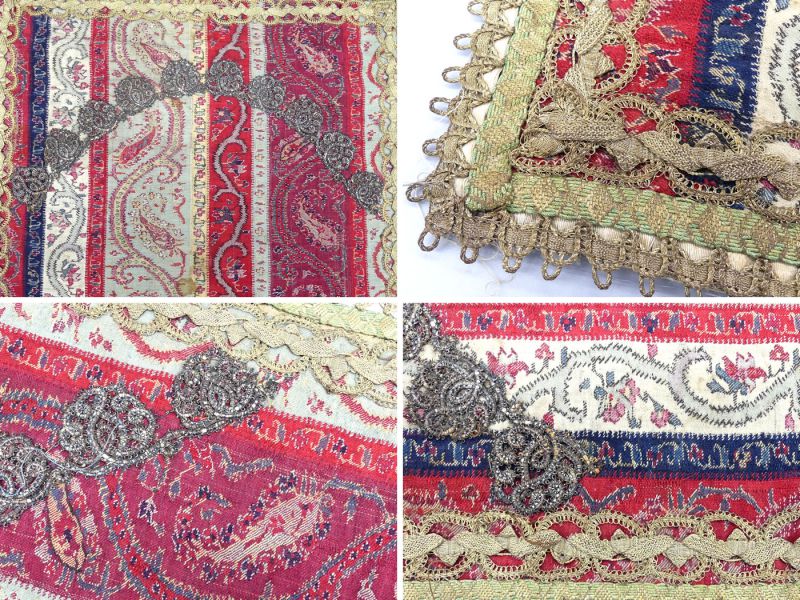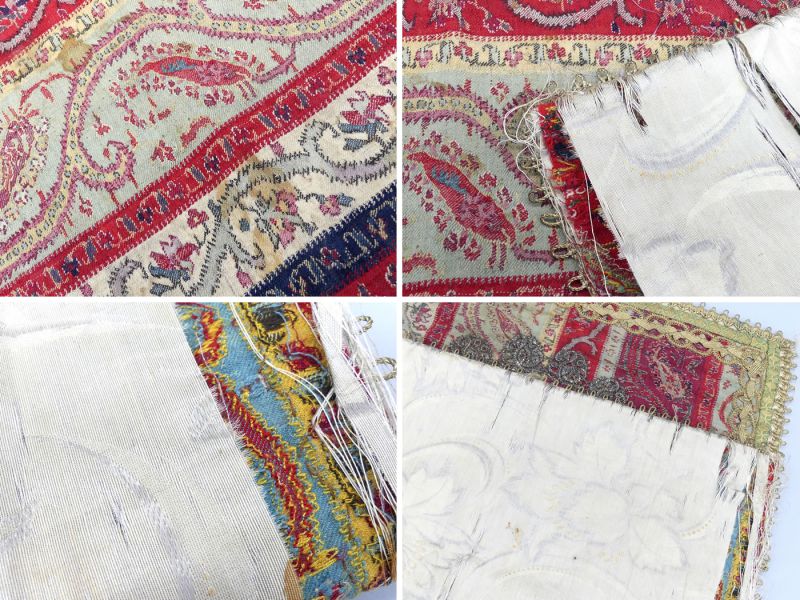Gebets-Teppich aus Kashmir 1840 – 1860
2598
Antike und sehr seltene kleine Gebets-Textilie (Gebets-Teppich) aus Kashmir (Indien - Kashmir 1840 – 1860); mit der typischen Boteh Jegheh (Paisley) Symbolik aus dem 19. Jahrhundert; Muslime verwendeten so kleine Textilien bei ihren Gebetspraktiken oft nur für ihre Stirn. Der Stoff ist in Rot, Beige und Grün gehalten; darauf die Nische (Bogen), gestickt aus Silberbrokat; die Nische entspricht der Mihrab in der Moschee und zeigt die Gebetsrichtung nach Mekka an; auf der Rückseite ist zum Schutz ein Seidentuch mit Blumenornamente aufgenäht welches starke Gebrauchsspuren aufweist, das Stoffmuster hat florale Muster und Boteh Jegheh Ornamente; Abschluss Ränder aus Goldbrokat gefertigt; der Begriff Paisley ist eine Bezeichnung aus Großbritanien und steht für das Boteh Jegheh" oder „Buta“, das Buta-Symbol ist ein tropfenförmiges Motiv, das seinen Ursprung im alten Persien hat; Beispiele für die Boteh Jegheh Symbole finden sich auf Textilien, Teppiche und in der Architektur alter Moscheen in Afghanistan, die bis ins 9. Jahrhundert zurückreichen; Traditionell wurde das Boteh Jegheh-Muster (Paisley) auch bei Religiösen-Textilien verwendet. Hinweise zu den Boteh Jegheh Symbolen und ihre Datierung findet man auch in dem Buch von Irwin, John, 1917- The kashmir shawl; Diese islamischen Textilien aus der viktorianischen Zeit sind sehr selten; in der Mitte ein paar Flecken (siehe Fotos); dem Alter entsprechende Gebrauchsspuren; das Objekt wurde von der „Art of Persepolis Inc.“ in NYC/USA nach Herkunft und nach Zeit der Herstellung eingeordnet; dem Alter entsprechende Gebrauchsspuren; Maße: 43x62 cm
Antique and rare small prayer textile (prayer rug) from Kashmir (India - Kashmir 1840 - 1860); with the typical Boteh Jegheh (Paisley) symbolism from the 19th century; Muslims often used such small textiles only for their foreheads during their prayer practices. The fabric is red, beige and green; the niche (arch) is embroidered in silver brocade; the niche corresponds to the mihrab in the mosque and indicates the direction of prayer to Mecca; a silk cloth with floral ornaments is sewn on the back for protection; the fabric pattern has floral designs and Boteh Jegheh ornaments; The end borders are made of gold brocade; the term paisley is a British term for "Boteh Jegheh" or "Buta", the buta symbol is a drop-shaped motif that originated in ancient Persia; examples of the Boteh Jegheh symbols can be found on textiles, carpets and in the architecture of ancient mosques in Afghanistan dating back to the 9th century. Traditionally, the Boteh Jegheh pattern (paisley) was also used on religious textiles. Notes on the Boteh Jegheh symbols and their dating can also be found in the book by Irwin, John, 1917- The kashmir shawl; These Islamic textiles from the Victorian period are very rared; a few stains in the centre (see photos); signs of wear commensurate with the age; the object was classified by the "Art of Persepolis Inc." in NYC/USA according to origin and according to the time of manufacture; signs of use corresponding to the age; dimensions: 43x62 cm


